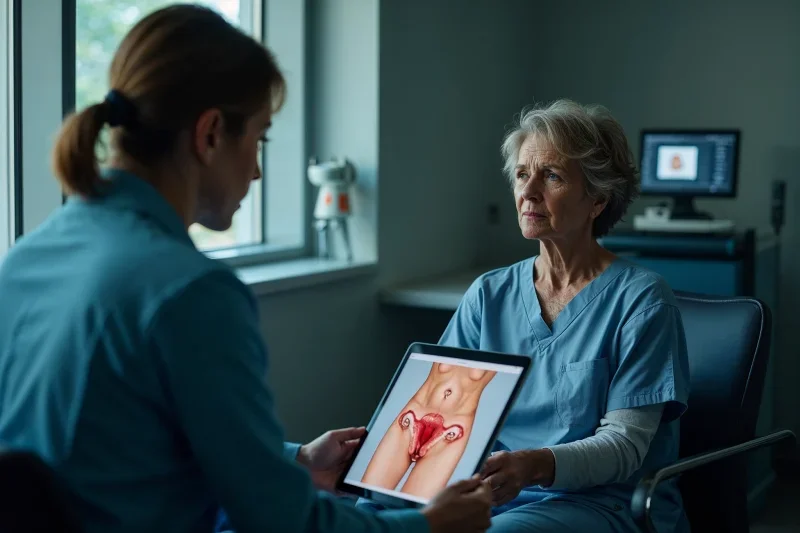Do You Lose Weight After Robotic Hysterectomy in Burleson, TX?
Categories:
By: Ethan Cole
A hysterectomy is a significant surgical procedure, and choosing a robotic, minimally invasive approach can make recovery smoother. Yet many patients still wonder, “Will I lose weight after surgery?” While robotic hysterectomy is not a weight loss surgery like gastric sleeve or other bariatric surgeries, the immediate post-operative period can trigger short-term changes on the scale. This in-depth guide—developed with input from North Texas Surgical Specialists and Dr. Jason Neef—explains what to expect, the role of robotic surgery in faster recovery, and practical strategies to keep your overall health on track in the Dallas–Fort Worth (DFW) area.
Key Takeaways
Most weight changes are temporary and driven by nausea, small incisions, IV fluids, and reduced activity, not by the removal of the uterus itself.
Robotic laparoscopic hysterectomy offers less pain, shorter hospital stays, and faster recovery times compared with traditional open surgery.
If ovaries are removed, hormonal shifts may slow metabolism; partnering with your healthcare provider for hormone management and lifestyle changes limits unwanted gain.
Gentle physical activities—walking, breathing drills, and light stretching—support circulation and significantly reduce the risk of complications.
Rapid weight loss, severe pain, leg swelling, or fevers over 100.4°F are red flags; call your surgeon immediately.
Burleson and Fort Worth residents have plenty of support: pelvic-floor PT, bariatric and general surgery follow-up, and women’s wellness groups to keep you on your journey to recovery.
Understanding Robotic Hysterectomy and Its Impact on Your Body
The Role of Robotic Surgery in Women’s Health
Robotic-assisted surgery uses a high-definition 3-D camera and wristed instruments that mimic the precise movements of a surgeon’s hands. Your general surgeon or gynecologic surgeon sits at a console, controls the robotic arms, and performs delicate tasks through five or six small incisions. These tiny entry points translate to less bleeding, less trauma, and smoother recovery compared with abdominal hysterectomy performed in a traditional open technique.
Types of Hysterectomy Performed Robotically
Partial hysterectomy (removal of the uterus, cervix remains)
Full hysterectomy (uterus + cervix)
Robotic-assisted total hysterectomy with bilateral salpingo-oophorectomy (uterus, tubes, and ovaries)
The type of surgery you need depends on your diagnosis and treatment plan—fibroids, endometriosis, cancer risk, or chronic pain. Discuss options with a team of specialists who hold American Board of Surgery credentials and are experienced in minimally invasive surgical techniques.
Surgical Process Highlights
Night prior to surgery: clear liquids after midnight; review medications.
Day of surgery: anesthesia is given; carbon dioxide gently inflates the surgical area for visibility.
Surgeon controls the robotic arms to detach the uterus with precise movements, protecting nerves and vessels.
Tissue is removed through a protected incision at the umbilicus or vagina.
Incisions are sealed with dissolvable sutures; most patients go home the same day or after one night, especially in the Texas Health Fort Worth area.
Why the Scale Fluctuates After Robotic Hysterectomy
Even though robotic techniques offer advantages of robotic precision, they can’t prevent every side effect tied to major surgery.
Nausea and appetite loss: Anesthesia slows digestion, making crackers and broth feel like a feast.
IV fluids: Extra saline can add two or three pounds that disappear as your kidneys work.
Constipation: Pain medication and reduced mobility can back things up, nudging the scale upward.
Hormonal disruption: If ovaries are removed, estrogen dips, which may alter fat distribution and basal metabolic rate.
Activity reduction: Fewer steps during the first two weeks means fewer calories burned.
Remember, these swings rarely signal true fat loss or gain. They’re part of the recovery process and usually normalize within four to six weeks.
Recovery Tips to Maintain a Healthy Weight
Nutrition Roadmap
Start with soft, protein-rich foods—Greek yogurt, cottage cheese, bone broth—to aid tissue repair.
Introduce complex carbs like oatmeal for fiber. Gradual fiber increase prevents bloating and promotes smooth bowel movements.
Hydrate generously: 64–80 oz of water flushes anesthesia by-products, supports the surgical site, and helps regulate hunger cues.
Limit processed sugar; swap soda for herbal tea with a splash of honey to keep inflammatory markers low.
Physical Activities for Faster Recovery
Hour-1 Rule: Every waking hour, stand up and walk at least five minutes. This simple habit promotes circulation and can significantly reduce risks of blood clots.
Seated heel raises and ankle pumps: Keep calf muscles active while protecting abdominal incisions.
Deep-belly breathing: Expands lungs, eases shoulder gas pain, and re-engages core muscles gradually.
After your six-week check, your healthcare provider may green-light low-impact cardio, resistance bands, or even water aerobics at the Burleson Area YMCA.
Mind–Body Support
Surgery—whether hysterectomy surgery or bariatric and general surgery—can amplify stress. Elevated cortisol may push the body toward fat storage. Consider guided meditation, journaling, or counseling through Texas Health Behavioral Services to keep your mental well-being aligned with physical healing.
Comparing Robotic Hysterectomy to Other Surgical Weight Loss Options
Patients sometimes confuse robotic hysterectomy with robotic weight loss surgery such as gastric sleeve surgery. Both use minimally invasive procedures and robotic technology, but their goals differ:
Robotic bariatric surgery (gastric sleeve, gastric bypass) is designed to achieve weight loss in cases of severe obesity.
Robotic hysterectomy treats gynecologic conditions; any weight change is collateral and generally temporary.
If you have concurrent health conditions that qualify for bariatric surgical care, discuss staging procedures with a bariatric surgeon in the DFW area. Coordinating care can optimize overall health and reduce multiple anesthesia events.
Long-Term Lifestyle Changes That Outlast Any Surgery
Even the most advanced robotic system can’t replace healthy habits. Once you’re cleared:
Strength train 2–3 times weekly to rebuild lean mass lost during downtime. Muscle boosts metabolism.
Aim for 150 minutes of moderate cardio—walking the Chisenhall Trail in Burleson counts.
Plan balanced meals with a plate method: half veggies, quarter protein, quarter complex carbs, plus healthy fat.
Sleep 7–9 hours nightly; poor rest disrupts ghrelin and leptin, hormones that control appetite.
Routine checkups: Annual visits with your general surgeon or gynecologic surgeon ensure scar integrity, while lab work tracks cholesterol and glucose.
When to Call Your Surgeon
Contact your surgical specialists right away if you notice:
Weight loss exceeding 5% of body weight in two weeks
Sudden weight gain paired with leg swelling or shortness of breath
Severe pain unrelieved by medication
Fever above 100.4°F, redness, or drainage at the surgical site
Early intervention can reduce the risk of complications and keep your path to recovery smooth.
Conclusion
Undergoing a hysterectomy—whether partial or full—can feel daunting, but advancements in robotic surgical techniques provide clear benefits: small incisions, less pain, and faster recovery times. Any post-operative weight change is usually short-lived and linked to anesthesia, hormones, and limited activity rather than fat loss. Focus on a nutrient-dense diet, gradual movement, and emotional well-being. In partnership with your Burleson or Fort Worth surgeon, you’ll transition from the hospital to a healthy, active life and safeguard long-term health and well-being.
Schedule your robotic hysterectomy consult in Burleson today.
Call (817) 568-8731Categories:
Frequently Asked Questions
-
Most patients resume desk duties within 2–3 weeks, thanks to the minimally invasive approach and shorter hospital stays. Heavy lifting or physically demanding jobs may require a full six weeks. Always follow individualized guidance from your healthcare provider to ensure a smooth recovery and avoid stressing the surgical area.
-
No. The surgeon controls the robotic arms from a console, translating hand movements into ultra-precise actions. Robotic technology simply enhances dexterity and vision, allowing complex procedures through small incisions. Your general surgeon remains in full command throughout the surgical procedure.
-
Hormone therapy is considered only if the ovaries are removed. Your provider will evaluate age, symptoms, and health conditions before prescribing estrogen or non-hormonal alternatives. A balanced approach helps maintain bone density, mood, and healthy weight after surgery.
-
Combining robotic weight loss surgery with hysterectomy is possible in select cases, but it increases operative time and complexity. A team of bariatric and general surgery specialists must assess risks, benefits, and insurance coverage. Many choose staged procedures for safer, faster recovery times.
-
Yes. Traditional open abdominal hysterectomy involves a larger incision, more pain, and a longer recovery process—often six to eight weeks. Robotic laparoscopic hysterectomy allows earlier ambulation, fewer narcotics, and lighter dietary restrictions, which can positively affect weight maintenance.
-
Follow your hospital’s protocol—usually clear liquids like broth, apple juice, and electrolyte drinks until midnight. Avoid heavy or fatty foods to reduce aspiration risk during anesthesia. Proper preparation for robotic surgery sets the stage for a faster, safer path to recovery.
-
Increase water intake, add soluble fiber such as oatmeal, and consider surgeon-approved stool softeners. Gentle walking also stimulates gut motility. Avoid over-the-counter laxatives unless advised, as some can cause cramping and stress the surgical site.
-
Up-front, robotic-assisted surgery can be slightly pricier due to specialized equipment. However, shorter hospital stays, faster recovery, and fewer complications often offset costs. Check with your insurance and the Texas Health billing team to understand coverage specifics.
-
Severe obesity may increase anesthesia risks and make positioning more challenging, but many surgeons skilled in robotic bariatric surgery successfully treat high-BMI patients. Pre-operative weight management and consultation with a bariatric surgeon can improve safety and outcomes.
-
Most women wait six weeks after a full or partial hysterectomy to allow complete healing of the vaginal cuff and internal tissues. Always get explicit clearance from your surgeon; resuming too early can cause bleeding or infection and prolong the journey to recovery.













